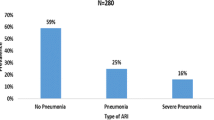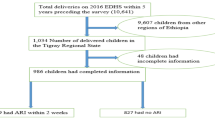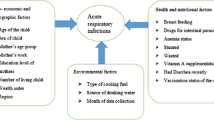Abstract
Objective
Acute respiratory infection is a leading cause of morbidity and mortality in under five children in developing countries. Hence, the present study was undertaken to identify various modifiable risk factors for acute lower respiratory tract infections (ALRI) in children aged 1 mth to 5 yr.
Methods
104 ALRI cases fulfilling WHO criteria for pneumonia, in the age group of 1 mth to 5 yr were interrogated for potential modifiable risk factors as per a predesigned proforma. 104 healthy control children in the same age group were also interrogated.
Results
The significant sociodemographic risk factors were parental illiteracy, low socioeconomic status, overcrowding and partial immunization, [p value <0.05 in all]. Significant nutritional risk factors were administration of prelacteal feeds, early weaning, anemia, rickets and malnutrition, [p value <0.05 in all]. Significant environmental risk factors were use of kerosene lamps, biomass fuel pollution and lack of ventilation [p value <0.05 in all]. On logistic regression analysis, partial immunization, overcrowding and malnutrition were found to be significant risk factors.
Conclusion
The present study has identified various socio-demographic, nutritional and environmental modifiable risk factors for ALRI which can be tackled by effective education of the community and appropriate initiatives taken by the government.
Similar content being viewed by others
References
A programme for controlling acute respiratory infections in children. Memorandum from a WHO meeting. Bulletin World Health Organization 1984; 62(1): 47–58.
Sikolia DN, Mwololo K, Cherop H, Hussein, Juma M, Kurui et al. The prevalence of acute respiratory infections and the associated risk factors: A study of children under five years of age in Kibera Lindi Village, Nairobi, Kenya.J.Nal/. Inst Public Health 2002; 51(1): 67–72.
Kabra SK. Acute respiratory tract infection (ARTI) Control program. In Ghai OP, Gupta P, Paul VK, eds. Ghai Essential Pediatrics. 5th edn. New Delhi, Interprint 2000; 349–350.
Technical Basis for WHO recommendations on the management of pneumonia in children at first level Health facilities WHO/ARI/91.20 Geneva, World Health Organization, 1991.
Park, K. Environment and Health In Park, K. eds. Park’s textbook of Preventive and Social Medicine. 17th edn. Jabalpurl M/S Banarsidas Bhanot, 2002: 489–562.
Cunha AL, Margolis PA, Wing S. Community economic development and acute lower respiratory infection in children. http://ww.jhpdc.unc.edu/journal41/ecdel.pdf
Broor S, Pandey RM, Ghosh M, Maitreyi RS, Lodha R, Singhal T et al. Risk factors for severe acute lower respiratory tract infection in under five children. Indian Pediatrics Dec 2001; 38: 1361–1367.
Graham NMH. The epidemiology of acute respiratory infections in children and adults. A global perspective Epidemiol. Rev 1990; 12: 149–178.
Victora CG, Smith PG, Vaughan JP, Barros FC, Fuchs SC. Risk factors for deaths due to respiratory infections among Brazilian infants. Int J Epidemiol 1989; 18: 901–908.
Illingworth RS, Normal breast feeding-physiology, chemistry and advantages. In The normal child-some problems of the early years and their treatment. Eds: Illingworth. R.S, 10th edition, New York; Churchill Livingstone, 1996; P 3–12.
Victora CG, Smith PG, Vaughan JP et al. Evidence for a strong protective effect of breast feeding against infant deaths due to infectious diseases in Brazil. Lancet 1987: ii: 319–322.
Lepage P, MunyaKazi C, Hennart P, Breast feeding and hospital mortality in children in Rwanda. Lancet 1981; 2: 409–411.
Lukens JN: Iron metabolism and iron deficiency. In: Miller DR, Bachner RL, Miller LP, eds. Blood Diseases of Infancy and Childhood. 7th edn. USA; Mosby-year book, Inc: 1990: 193–215.
Najada. AS, Habashneh MS, Khader M, The frequency of nutritional rickets among hospitalized infants and its relation to respiratory diseases. J Tropical Pediatrics 2004; 50(6): 364–368.
Udani PM. Vitamin D and deficiency Rickets In Udani PM, eds. Textbook of Pediatrics. 1st edn. New Delhi; Jaypee brothers 1998; 631-666.
Yoon PW et al. The effect of Malnutrition on the risks of diarrheal and respiratory mortality in children less than 2 years of age in Cebu,Philippines. American J Clinical Nutrition, 1997; 65: 1070–1077.
Sehgal V, Sethi GR, Sachdev HPS, Satyanarayana L. Predictors of mortality in subjects hospitalized with Acute lower respiratory tract infections. Indian Pediatrics 1997; 34: 213–218.
Rice AL, SaccoL, Hyder A, Black RE. Malnutrition as an underlying cause of childhood deaths associated with infectious diseases in developing countries. Bulletin World Health Organization 2000; 78(10): 1207–1221.
Alleyne GAO, Hay RW, Picou DI, Stanfield JP, Whitehead RG-Interaction between infection and malnutrition In Alleyne GAO, Hay RW, Picou DI, Stanfield JP, Whitehead PG, eds. Protein Energy Malnutrition. 1st edn. New Delhi; Jaypee Brothers 1989, 93–102.
Heird WC, Vitamin deficiencies and excesses In Behrman RE, Kliegman RM, Jenson HB, eds. Nelson textbook of Pediatrics, 17th edn. Philadelphia; Saunders 2004; 177-190.
Smith KR, Samet JM, Romieu I, Bruce N. Indoor air pollution in developing countries and acute lower respiratory infections in children. Thorax 2000; 55: 518–531.
Sharma S, Sethi GR, Rohtagi A, Chaudhary A, Shankar R, Bapna JS et al. Indoor air quality and acute lower respiratory tract infection. Indian Environ Health Perspect 1998; 106: 291–297.
Cook DG, Strachan DP. Summary of effects of parental smoking on the respiratory health of children and implications for research. Thorax 1999; 54: 357–366.
Committee on environmental Hazards. Involuntary smoking — a hazard to children. Pediatrics 1986; 77: 755–777.
Guidelines for research on acute respiratory infections: Memorandum from a WHO meeting. Bulletin World Health Organization 1982; 60(4): 521–533.
Author information
Authors and Affiliations
Corresponding author
Rights and permissions
About this article
Cite this article
Savitha, M.R., Nandeeshwara, S.B., Pradeep Kumar, M.J. et al. Modifiable risk factors for acute lower respiratory tract infections. Indian J Pediatr 74, 477–482 (2007). https://doi.org/10.1007/s12098-007-0081-3
Received:
Accepted:
Published:
Issue Date:
DOI: https://doi.org/10.1007/s12098-007-0081-3




